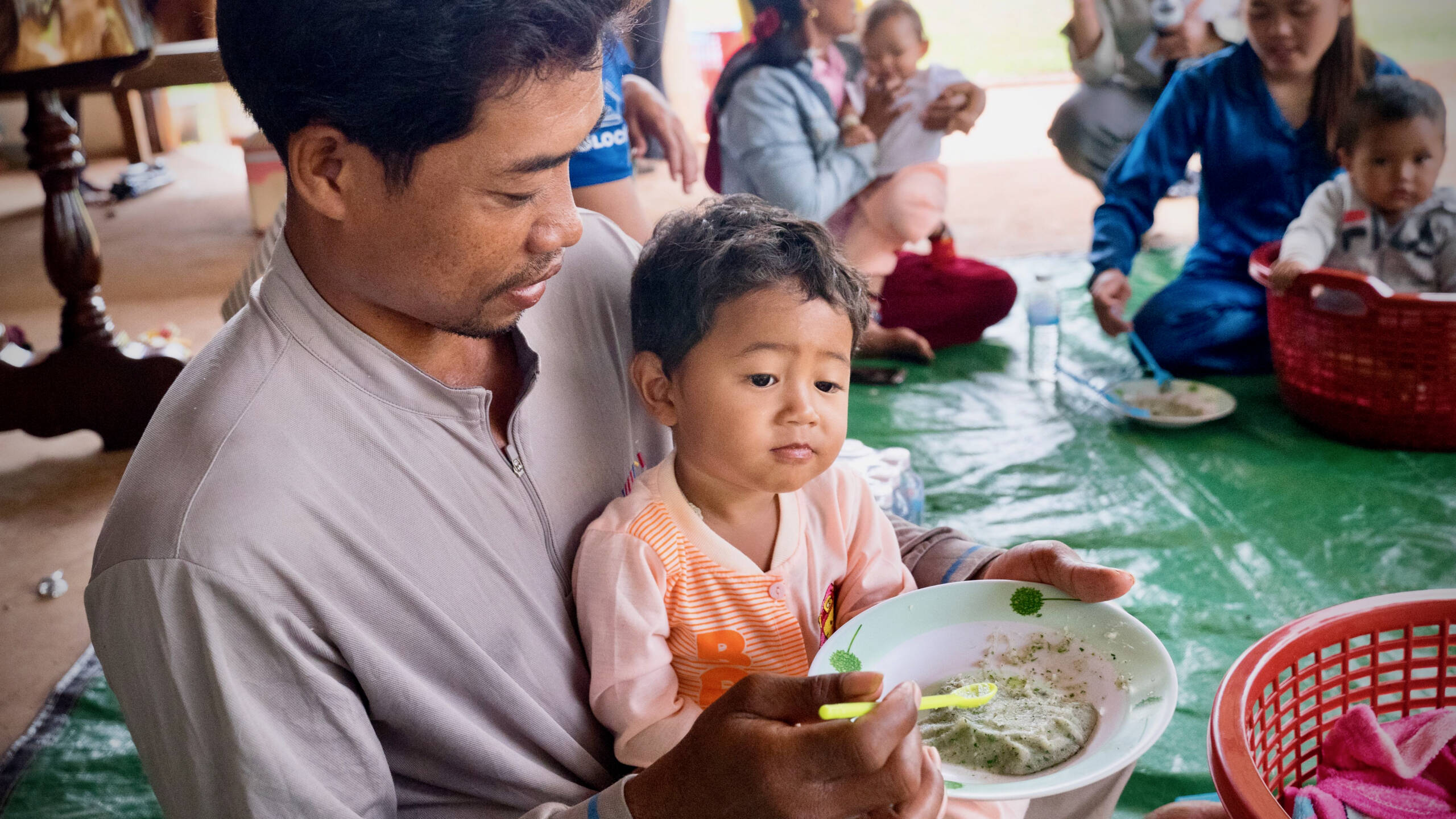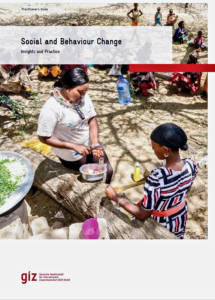How to Bridge the Gap Between Knowledge and Action
How to Bridge the Gap Between Knowledge and Action
Social and behaviour change is key to achieve food and nutrition security as well as to reach the SDGs

Cambodia, MUSEFO, training on complementary feeding with moringa involving men
Photo by Michael Joos
Photo by Michael Joos
Change processes are central to the success of our projects. One of the most important conditions to reach project goals is people starting to adopt and sustain new behaviours. Therefore, many projects in different sectors support and facilitate change processes.
For example, in the area of food and nutrition security, social and behavior change activities are often geared towards mothers encouraging them to adopt healthier eating habits, practice adequate feeding and adapt cooking or hygiene practices. In agriculture and value chain projects, the focus is on smallholder farmers and enterprises who are encouraged and supported to take up practices such as improved agronomic methods, soil protection and rehabilitation measures, use of improved seed varieties and elaboration of effective long-term business practices.
Social and Behaviour Change (SBC) is a process involving individuals, communities and societies that enables them to adopt and sustain positive behaviours.
BMZ´s discussion paper on “approaches using behavioral insights in the German Development cooperation” refers to insights of the 2015 Woldbank Development Report “Mind, Society, and Behavior”. It highlights the potential to use behavioural insights to make the approaches used by German development cooperation more effective and generate a broad or broader impact. The report highlights that human beings should be at the center of the approaches taken by cooperation.
What concerns our activity, yes, for social and behavior change processes the human being is at the center of our activities. He or she should adopt and sustain a certain behaviour. Nevertheless, the environment and many other factors play an important role. They influence whether people are able to adopt a certain behaviour at all.
Who has never acted contrary to one’s better knowing? Assuming that everybody has experienced situations when he or she resisted change, knowing that doing otherwise would be a much better option, you’ll probably agree that often it’s simply not enough to raise awareness and disseminate knowledge. We all know that regular exercise is healthier than chilling on the sofa, chowing chocolate bars. What encourages us to pick a healthier option, what keeps us away from it? Let’s discover the factors and key determinants impacting human behaviour. How do we transition knowledge into action?
One lesson learned from previous studies
Behaviour change goes beyond, in to one’s personal domain. It requires the support of a social group or society an individual is set in. Psychological, cultural, religious, social and economic factors may motivate or hinder behaviour change and thus should be identified, analysed and addressed when designing successful activities.
 One of the most common models to illustrate this is the socio-ecological model. It outlines that our behaviour is determined by a range of personal and external factors at four levels:
One of the most common models to illustrate this is the socio-ecological model. It outlines that our behaviour is determined by a range of personal and external factors at four levels:
- At the individual level, a person’s knowledge, skills, self-confidence, life experience, socio-economic status, age, health, and other factors are important.
- The next level comprises close relationships that have a huge impact on someone’s behaviour — partner, family, friends, close classmates and colleagues.
- Then you have the community level, which can be supportive or discouraging in terms of behaving in a new way. It includes various local-level groups and institutions such as a savings group or a school, the presence and performance of providers of commercial and public services (shops, health facilities, transportation) and local authorities (e.g. traditional leaders).
- Lastly, there are societal levels, including government policies, budget allocation, culture, religion, media, economy and the environment. The latter are factors an individual is least capable of influencing. So clearly sustained behaviour change cannot be achieved without considering — and, if possible, addressing — the underlying social and environmental factors simultaneously.
Yet, every influencing factor brings a very important aspect: the perspective of the target group matters most. We have to know and understand the perception, the background and the circumstances of the target group in order to effectively design activities for behaviour change – what WE think is not relevant.
11 factors keeping people from doing what the should rather do
So, what determines whether people practice desired behaviour or not? Eleven key factors are frequently mentioned in assessments to understand what prevents people from practising desired behaviours and on the other hand, what could motivate them to do so. These are:
- Perceived self-efficacy
- Perceived social norms
- Perceived positive consequences
- Perceived negative consequences
- Access (to goods or services required to practice the behaviours)
- Cues for action or reminder
- Perceived vulnerability
- Perceived severity
- Perceived action efficacy
- Policy
- Culture
It’s good to know if an individual really believes that she or he can perform a particular behaviour (perceived self-efficacy). This is linked to her/his current knowledge, abilities, self-confidence and resources. For example, farmers who intend to grow vegetables for household consumption might not feel confident with dealing with the pests that attack their crops.
Human behaviour is also determined by perceived social norms. “Do people who are important to me think I should behave in certain way?” For example, husbands might be concerned about their friends laughing at them if they take care of a “woman’s’ task” at home.
Positive or negative consequences also affect human behaviour. What may happen to me as a result of performing a certain act? This might be, for example, health-related — e.g. “feeding my child an egg every day will help her to grow well”. This can also be much less ‘rational’, such as positive feelings of comfort, peace of mind or feeling good about oneself. Another key factor is the perceived vulnerability. This is about someone’s perception of how vulnerable she/he feels about a problem. For example, how a mother feels about how likely it is that her child could become undernourished.
These examples illustrate that disseminating knowledge and raising awareness may not necessarily lead to action. Therefore, before we start to design activities for social and behaviour change, it is a good idea to analyse these determinants in order to identify and understand the barriers and motivators of the priority group to adopt or not adopt a given behaviour.
As more and more projects use the insights from behavioural science to support behaviour change processes, the Sector Project Agricultural Policy and Food and Nutrition Security developed a practitioner’s guide on social and behaviour change. The guide aims to support projects with facilitating SBC processes in a structured and systematic way. It guides practitioners like you step by step through the design and implementation of social and behaviour change activities.
Download: Practitioner´s Guide on Social and Behaviour Change
French edition: Guide du praticien-Changement social et comportemental
French edition: Guide du praticien-Changement social et comportemental
Theory and practical guides are important to guide our activities
Now, let’s have a look at the experiences on the ground. How do individual projects implement their specific activities regarding social and behaviour change? What are the challenges to implementation and how are they overcome?
We are pleased to share with you insights on social and behaviour change from projects in seven different countries, five in Africa and two in Asia. While the projects have different foci, they all aim at changing behaviors towards improving the food, nutrition and health situation in an effective and sustainable way.
The project in India conducted a social and behaviour study and identified enablers as well as barriers for good nutrition practices among their target group. The development of key messages and ways to measure behaviour change is the priority in the article from Burkina Faso. The project in Kenya focuses on participatory training and especially on how to create profound knowledge and turn it into action. In Benin, the project engages in participatory cooking demonstrations and developed a brief guiding manual for volunteers with recipes and quality standards. The project in Cambodia describes activities on how to address the double burden of malnutrition and how to implement the care group approach. Both projects in Burundi and Ethiopia use media campaigns as drivers for social and behaviour change. The project in Burundi focuses on adequate handling of drinking water and basic hygiene and sanitation practices. The project in Ethiopia collaborates with a famous singer as nutrition ambassador for dietary diversity.
There’s more for you to read
Enjoy reading the articles from the different countries and in case you have questions about the practitioner’s guide or the activities in the countries, you are most welcome to drop an e-mail to the person in charge. We thank the Global Programme Food and Nutrition Security, Enhanced Resilience as well as the Water and Sanitation Sector Programme in Burundi for submitting these articles.
- Using Celebrities as Ambassadors for Better Nutrition
- Is Mass Media the High Road to Behaviour Change?
- How To Achieve Knowledge In the Community and Convert It Into Practice
- Let’s Cook, Benin!
- Tackling the Double Burden of Malnutrition
- Measuring Behaviour Change Using Key Messages
- Enablers and Barriers to Good Nutrition Practices
Contacts
Annette Roth (Sector Project Agricultural Policy and Food and Nutrition Security), Julia Goette (Sector Project Agricultural Policy and Food and Nutrition Security), Anna- Vanessa Kullanek (Global Programme Food and Nutrition Security, Enhanced Resilience, country package Kenya)


